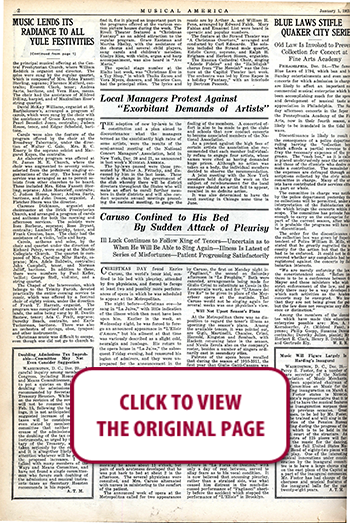 100 YEARS AGO IN MUSICAL AMERICA (370)
100 YEARS AGO IN MUSICAL AMERICA (370)
January 1, 1921
Page 2
Caruso Confined to His Bed By Sudden Attack of Pleurisy

Ill Luck Continues to Follow King of Tenors—Uncertain as to When He Will Be Able to Sing Again—Illness Is Latest of Series of Misfortunes—Patient Progressing Satisfactorily
CHRISTMAS DAY found Enrico Caruso, the world’s tenor idol, confined to his bed with pleurisy, attended by five physicians, and forced to forego at least two and possibly more performances of opera in which he was scheduled to appear at the Metropolitan.
The night before—Christmas eve—he sang in “La Juive,” with little indication of the illness which then must have been upon him. Earlier in the week, on Wednesday night, he was forced to forego an announced appearance in “L’Elisir d’Amore,” but his ailment at that time was variously described as a slight cold, neuralgia and lumbago. His return to the opera house in “La Juive,” the subsequent Friday evening, had reassured his legion of admirers, and they were unprepared for the announcement in the press which followed, adding another chapter to the recent troubles of the king of tenors.
This announcement did not appear in the newspapers until Monday morning, although Caruso had been in bed since shortly after noon Saturday. Monday afternoon the five physicians in attendance on the stricken singer issued a reassuring bulletin, in which they stated that he was in less pain, that the ailment was taking a normal course, and that no complications were feared. The bulletin was signed by Drs. Samuel Lambert, Evan M. Evans, Antonia Stella, Francis J. Murray and Philip Horowitz.
From Mr. Caruso’s secretary, Bruno Zirato, it was learned that the tenor on Friday helped to decorate the Christmas tree for little Gloria Caruso. In the evening he sang in “La Juive,” and it was late when he retired. Christmas morning he arose about 11 o’clock, but pain of such acuteness developed that he was put back to bed at about 2 in the afternoon. The several physicians were consulted, and Mrs. Caruso alternated with nurses in ministering to the comfort of the patient.
The announced week of opera at the Metropolitan called for two appearances by Caruso, the first on Monday night in “Pagliacci,” the second on Saturday afternoon in “Le Prophète.” Both were canceled, arrangements being made for Giulio Crimi to substitute as Canio in the Leoncavallo work, and for “L’Amore dei Tre Re” to be given in place of the Meyerbeer opera at the matinée. That Caruso would not be singing again for several weeks was one physician’s view.
Will Not Upset Season’s Plans
At the Metropolitan there was no disposition to regard the tenor’s illness as upsetting the season’s plans. Among the available tenors, it was pointed out, are Gigli, Martinelli, Chamlee, Crimi, Harrold, Kingston and Sembach, with Hackett returning later in the season, and Nicola Zerola also on the company’s roster, besides a number of singers ordinarily cast in secondary roles.
Patrons of the opera house recalled that during the season of 1910-1911, the first year that Giulio Gatti-Casazza was general manager of the opera house, Caruso was absent during the latter half of the season because of throat trouble. He made his final appearance that season on F eb. 6, 1911, and was not again heard -at the Metropolitan until the opening of the following season on Nov. 13.
At that time General Manager GattiCasazza was quoted as saying that “No one is indispensable. I am not indispensable myself.” An incident of interest was the issuance of a statement by the famous throat specialist, Dr. Holbrook Curtis, since deceased, denying many rumors of injury to the tenor’s vocal apparatus.
No such alarm has been manifest among music patrons over the latest illness of Caruso, as diagnosed by his physicians, as was shown when he burst a blood vessel two weeks before while singing in Brooklyn. The singer ‘s quick “come back” after that incident, as seen in his fine singing of the rôle of Don Alvaro in “La Forza de Destino,” with only a day of rest between, served to allay fears as to his vocal condition. It is now believed that oncoming pleurisy, rather than a strained side, was what caused him distress in the much-discussed performance of “Pagliacci” shortly before the accident which stopped the performance of “L’Elisir” in Brooklyn.



 RENT A PHOTO
RENT A PHOTO





